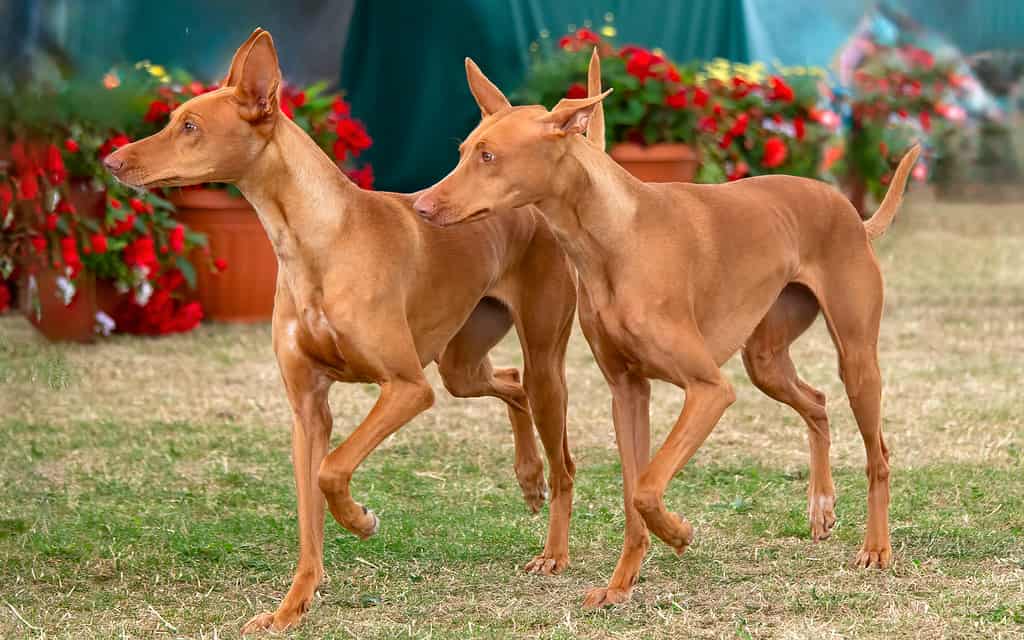Pharaoh hounds come in brown – and that’s about it. However, their brown color is divided into four different categories depending on the tone. Therefore, there are technically four pharaoh hound colors for potential owners to choose from.
Each coloration can also come with white markings, though these aren’t extensive and typically only appear on their feet, neck, and belly. We’ll review each of these colors below with descriptions and picture examples.
Pharaoh hounds have three genes that control their coloration. B and E genes control the base color. Si genes control whether or not the dog has white markings. We’ll discuss what coloration requires what genes below, as well.
1. Chestnut

This pharaoh hound is rather darkly colored, putting it into the chestnut category. He does not have any white markings, though that is possible with this coloration.
©Hanna Dymytrova-Kaihila/iStock via Getty Images
Dogs in the darkest category are labeled “chestnut.” They’re a dark brown that is rather rich in color. These dogs are very common, as this color requires no recessive traits. If a dog inherits one dominant B and two dominant Es, they will be chestnut.
In most cases, a chestnut pharaoh hound will have 25% chestnut offspring – no matter what dog they’re bred with. In some cases, that statistic may be as high as 50%, depending on exactly what genes the chestnut parent carries.
The white marking gene is recessive, so fewer dogs have white markings than those without.
Many breeders consider chestnut the “default” color, especially if the dog doesn’t have white markings. You should have no problem finding this color at any breeder, and they’re commonly spotted in the show ring.
2. Red Golden

Red golden pharaoh hounds are a step below the chestnut. They tend to have a very red pigment.
©Eudyptula/iStock via Getty Images
If a dog inherits a dominant B gene but no dominant E gene, they end up red golden. Again, these dogs can have white markings, but it is much more common for them not to have white markings. Typically, white markings are rearer, as it requires inheriting two recessive traits.
In other words, pharaoh hounds won’t have white markings unless both parents have white markings. Otherwise, the puppy will likely be solid (though white markings can still appear randomly in rarer cases).
It’s pretty easy to find red golden pharaoh hounds. They’re a bit less common than chestnuts, but many breeders still produce them. It can be hard to tell the difference between a red golden and a chestnut at birth, so breeders may not tell you what puppies they have right away.
3. Rich Tan

Pharaoh hounds also come in a rich tan color, which doesn’t have the red undertone of the rich golden or chestnut.
©Eudyptula/Shutterstock.com
The “rich tan” color can most accurately be described as brown. These dogs don’t have the same reddish undertone as the previous colors. Instead, they’re far more tan than chestnut.
Dogs end up tan when they have at least one B gene and only one E gene. That means a dog might be BB Ee or Bb Ee. They can also have white markings if they end up with the genes for it. White markings are recessive, as we’ve stated previously, so they are rarer than solid-colored dogs.
These canines aren’t very rare. Many litters have these dogs, even if they don’t technically “specialize” in them. They should not be any more expensive than your average pharaoh hound, either.
4. Tan

Tan pharaoh hounds are the lightest and rarest color. Finding them may require going to a specialized breeder.
©Sue Thatcher/iStock via Getty Images
Dogs that do not inherit any dominant B gene are tan. It is one of the rarest because dogs have to inherit two recessive b genes for this coloration to occur. The dog’s parents must either be tan or carry a recessive b gene. If both parents carry a recessive b gene, then around 25% of their puppies will be tan.
None of the puppies will be tan if either parent has two dominant B genes.
Just like any other pharaoh hound, these dogs can have white markings. However, they have to inherit the recessive white marking gene for this to occur.
These dogs are not incredibly common, as they require very specific genetics to fall into place. Your best bet is to look for breeders breeding tan pharaoh hounds, as they have the highest rate of producing tan puppies. Furthermore, be extra-cautious with health problems. Because breeders often breed two tan dogs together to produce more tan puppies, inbreeding and genetic problems are more common.
Ready to discover the top 10 cutest dog breeds in the entire world?
How about the fastest dogs, the largest dogs and those that are -- quite frankly -- just the kindest dogs on the planet? Each day, AZ Animals sends out lists just like this to our thousands of email subscribers. And the best part? It's FREE. Join today by entering your email below.
Thank you for reading! Have some feedback for us? Contact the AZ Animals editorial team.








